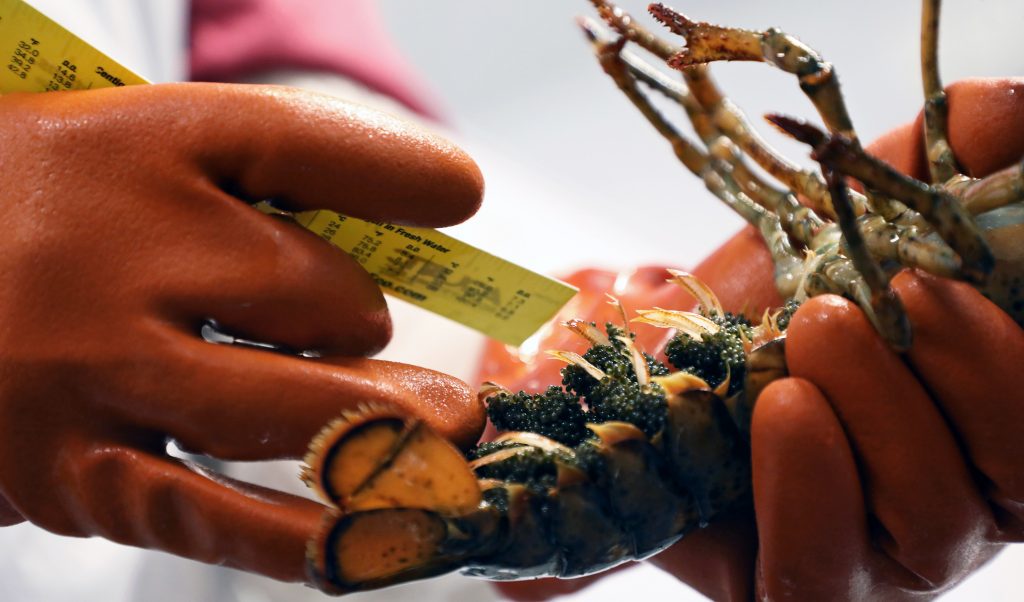Research into American Lobster Reproduction

A New Interactive StoryMap Highlights Projects from the Sea Grant American Lobster Initiative
A new web-based StoryMap highlights research being conducted by scientists into the reproduction of the American lobster. The scientific studies and the work to communicate about them are part of the American Lobster Initiative of the National Oceanic and Atmospheric Administration’s National Sea Grant College Program.
The American lobster fishery is one of the largest and most economically valuable single-species fisheries in the United States. Yet it is a fishery in a sea of change – with many outstanding questions about how the changing environment will impact it.
To look for answers to these questions, the NOAA Sea Grant American Lobster Initiative funded 24 research projects to-date aimed at understanding the physical and chemical changes affecting American lobster. Scientists funded through the project are investigating pressing questions about American lobster’s life history, predation and other stressors, spatial distribution, as well as gear technologies and the industry socio-economics. Four of the funded projects focus on pressing questions about reproduction in the American lobster.
Reproduction is a crucial aspect of lobster biology because it determines the growth and trajectory of the population. Lobsters are sensitive to changes in water temperature; however a better understanding is needed of the factors that impact its growth, maturity, and migration.
The Research into American Lobster Reproduction StoryMap is the first in a series produced by Woods Hole Oceanographic Institution (WHOI) Sea Grant staff Jennie Rheuban, Stephanie Murphy and Simonne Dodge, a student intern with WHOI Sea Grant from the University of Miami who led the project. The StoryMap provides a highly visual overview of this important research and will help raise awareness and understanding of the state of this iconic fishery.
The four “reproduction” research projects featured in the StoryMap are led by Emily Rivest, Virginia Institute of Marine Sciences; Jason Goldstein, Wells National Estuarine Research Reserve, and Jesica Waller, Maine Department of Marine Resources and involve multiple institutions. Each project addresses different gaps in our understanding of lobster reproduction, asking such questions as:
- Is the stress of warming water causing female lobsters' ability to reproduce to decline in southern New England?
- How are the changing ocean temperatures and chemistry impacting egg-bearing lobsters and their early stage offspring?
- How are warming waters impacting the movements and behavior of lobsters at every stage of their life cycle?
- Are there non-lethal methods of determining the maturity of female American lobsters that can be developed to inform the lobster fishery management?
The research is still underway. The StoryMap will be updated as the researchers continue to produce results and analysis.
“The goal of the ALI is to increase the American lobster industry’s resilience to the biological, economic, and social impacts of ecosystem change,” says Rheuban, the research coordinator at WHOI Sea Grant. “The research is addressing critical knowledge gaps about American lobster and its iconic fishery in a dynamic and changing environment.”
WHOI Sea Grant will release five more StoryMaps this spring to cover all 24 research projects. All of the StoryMaps, including one released last year that provides broad context on American Lobster called “A Fishery in a Sea of Change,” will be linked from a StoryMap Collection. See a complete list of the ALI-funded research projects on the ALI website.
About the ALI
The Sea Grant American Lobster Initiative (ALI) supports scientific research about the American lobster and its iconic fishery through funding from the National Oceanic and Atmospheric Administration’s National Sea Grant College Program. This Initiative began in 2019 with the goal of increasing the American lobster industry’s resilience to the biological, economic, and social impacts of ecosystem change in the Gulf of Maine, Georges Bank, and southern New England.
About WHOI Sea Grant
Based at Woods Hole Oceanographic Institution, the WHOI Sea Grant program encourages environmental stewardship, long-term economic development, and responsible use of the nation’s coastal and ocean resources. The program supports research and education, and an extension program in collaboration with the Cape Cod Cooperative Extension. It is part of the NOAA-funded National Sea Grant College Program, a network of 34 individual programs located in each of the coastal and Great Lakes states. More information can be found at seagrant.whoi.edu.
April 17, 2023
